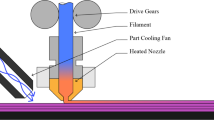Abstract
This paper presents an analysis of a scanner-based laser cladding process and its integration into a hybrid machining center. After deducing a robust set of process parameters from experiments for scanner-based cladding which reliably yield defined geometries, we present an automation architecture to encapsulate the hardware that is specific to this process. We then describe a planning approach in CAM software to facilitate using the scanner-based cladding process within a planning framework for milling processes. After introducing a hybrid laser tool which enables new stabilizing process possibilities we conclude with an approach to combine all these findings into a seamless machine concept of which we present a prototype.











Similar content being viewed by others
Abbreviations
- v d :
-
Wire feed rate [mm/min]
- v :
-
Laser feed rate [mm/min]
- P l :
-
Laser power [W]
- v o :
-
Oscillation speed of the laser spot [mm/s]
References
Bichmann S, Emonts M, Glasmacher L, Kordt M (2006) Automatisierte Reparatur-Fertigungszelle für den Werkzeugbau basierend auf optischer In-Prozess-Messtechnik und laserintegrierter Bearbeitung–OptoRep. Eigenverlag Fraunhofer IPT, Aachen
Brecher C, Breitbach T, Do-Khac D, Herfs W, Karlberger A, Klein W, Heinen D, Rosen C-J (2009) Prozessketten hochveredelter Produkte verkürzen. ZWF Zeitschrift für wirtschaftlichen Fabrikbetrieb 9:739–744
Brecher C, Karlberger A (2010) Steuerungskonzept für ein hybrides Bearbeitungszentrum. In: Hybride Technologien in der Produktion. Fortschritt-Berichte VDI Reihe 2, Fertigungstechnik. VDI Verlag, Düsseldorf
Brecher C, Klocke F, Wenzel C, Emonts M, Frank J (2008) KombiMasch–hybride Werkzeugmaschine zur Verkürzung der Prozesskette. wtOnline 7(8):525–532
Chang T-C, Wysk RA, Wang H-P (2006) Computer Aided Manufacturing. Prentice Hall, Englewood
Haferkamp H, Bach FW, Gerken J, Ebsen H (1993) Laserstrahlauftragschweißen an Bauteilen für den industriellen Einsatz. Schweißen und Schneiden Band 45(9):513–515
Klocke F, Scheller D (1997) Process monitoring in laser surface treatment operations with reflection and temperature measurement. Production Engineering 4(1):39–44
Kramer T, Proctor F (2010) Feature-based Process Planning based on STEP. In: Xun X, Ching AY (eds) Advanced Design and Manufacturing Based on STEP. Springer Series in Advanced Manufacturing, Heidelberg
Kuchling H (1996) Taschenbuch der Physik. Fachbuchverlag, Leipzig
Leondes CT, Chen Y-M, Lee R-S (2003) Computer Aided and Integrated Manufacturing Systems Vol. 5. World Scientific Pub Co, Hackensack, NJ
Nowotny S, Thieme S, Scharek S, Rönnefahrt T, Gnann RA (2008) FLEXILAS—laser precision technology for deposition welding with centric wire feeding. In: Die Verbindungsspezialisten 2008. DVS Media, Düsseldorf, pp 318–322
Partes K (2009) Analytical model of the catchment efficiency in high speed laser cladding. Surf. Coat. Technol. doi:10.1016/j.surfcoat.2009.07.041
Vaccari JA (1990) The laser as a cladding tool. American Machinist 134(2):49–52
Vilar R Laser Alloying and Laser Cladding. Materials Science Forum. doi:10.4028/www.scientific.net/MSF.301.229
Wilden J (2005) Beschichten mit dem Laserstrahl. Verschleiß- und Verschleißschutz von Schnecken und Zylindern für Extruder und Spritzgießmaschinen. S. M0–M26
Acknowledgments
The authors would like to thank the German Research Foundation DFG for the support of the depicted research within the Cluster of Excellence “Integrative Production Technology for High-Wage Countries”.
Author information
Authors and Affiliations
Corresponding author
Rights and permissions
About this article
Cite this article
Brecher, C., Klocke, F., Breitbach, T. et al. A hybrid machining center for enabling new die manufacturing and repair concepts. Prod. Eng. Res. Devel. 5, 405–413 (2011). https://doi.org/10.1007/s11740-011-0323-0
Received:
Accepted:
Published:
Issue Date:
DOI: https://doi.org/10.1007/s11740-011-0323-0




